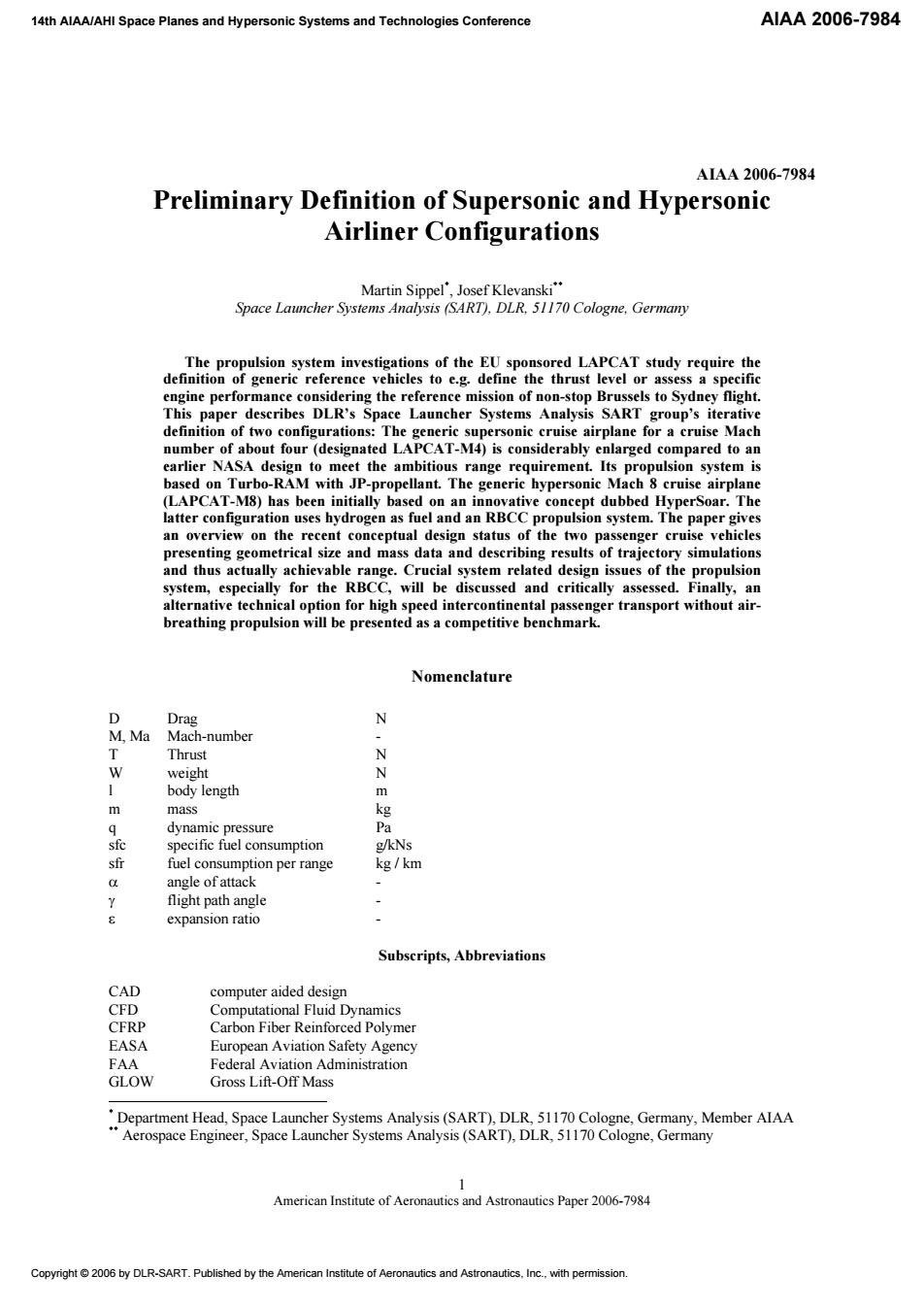正在加载图片...

14th AlAA/AHI Space Planes and Hypersonic Systems and Technologies Conference AIAA2006-7984 ALAA2006-7984 Preliminary Definition of Supersonic and Hypersonic Airliner Configurations Martin Sippel',Josef Klevanski Space Launcher Systems Analysis(SART),DLR,51170 Cologne,Germany The propulsion system investigations of the EU sponsored LAPCAT study require the definition of generic reference vehicles to e.g.define the thrust level or assess a specific engine performance considering the reference mission of non-stop Brussels to Sydney flight. This paper describes DLR's Space Launcher Systems Analysis SART group's iterative definition of two configurations:The generic supersonic cruise airplane for a cruise Mach number of about four(designated LAPCAT-M4)is considerably enlarged compared to an earlier NASA design to meet the ambitious range requirement.Its propulsion system is based on Turbo-RAM with JP-propellant.The generic hypersonic Mach 8 cruise airplane (LAPCAT-M8)has been initially based on an innovative concept dubbed HyperSoar.The latter configuration uses hydrogen as fuel and an RBCC propulsion system.The paper gives an overview on the recent conceptual design status of the two passenger cruise vehicles presenting geometrical size and mass data and describing results of trajectory simulations and thus actually achievable range.Crucial system related design issues of the propulsion system,especially for the RBCC,will be discussed and critically assessed.Finally,an alternative technical option for high speed intercontinental passenger transport without air- breathing propulsion will be presented as a competitive benchmark. Nomenclature D Drag N M.Ma Mach-number T Thrust N W weight N 1 body length 今 m mass kg 9 dynamic pressure Pa sfe specific fuel consumption g/kNs sfr fuel consumption per range kg/km angle of attack flight path angle expansion ratio Subscripts,Abbreviations CAD computer aided design CFD Computational Fluid Dynamics CFRP Carbon Fiber Reinforced Polymer EASA European Aviation Safety Agency FAA Federal Aviation Administration GLOW Gross Lift-Off Mass 'Department Head,Space Launcher Systems Analysis(SART),DLR,51170 Cologne,Germany,Member AIAA "Aerospace Engineer,Space Launcher Systems Analysis(SART),DLR,51170 Cologne,Germany 1 American Institute of Aeronautics and Astronautics Paper 2006-7984 Copyright2006 by DLR-SART.Published by the American Institute of Aeronautics and Astronautics,Inc.,with permissionAmerican Institute of Aeronautics and Astronautics Paper 2006-7984 1 AIAA 2006-7984 Preliminary Definition of Supersonic and Hypersonic Airliner Configurations Martin Sippel* , Josef Klevanski** Space Launcher Systems Analysis (SART), DLR, 51170 Cologne, Germany The propulsion system investigations of the EU sponsored LAPCAT study require the definition of generic reference vehicles to e.g. define the thrust level or assess a specific engine performance considering the reference mission of non-stop Brussels to Sydney flight. This paper describes DLR’s Space Launcher Systems Analysis SART group’s iterative definition of two configurations: The generic supersonic cruise airplane for a cruise Mach number of about four (designated LAPCAT-M4) is considerably enlarged compared to an earlier NASA design to meet the ambitious range requirement. Its propulsion system is based on Turbo-RAM with JP-propellant. The generic hypersonic Mach 8 cruise airplane (LAPCAT-M8) has been initially based on an innovative concept dubbed HyperSoar. The latter configuration uses hydrogen as fuel and an RBCC propulsion system. The paper gives an overview on the recent conceptual design status of the two passenger cruise vehicles presenting geometrical size and mass data and describing results of trajectory simulations and thus actually achievable range. Crucial system related design issues of the propulsion system, especially for the RBCC, will be discussed and critically assessed. Finally, an alternative technical option for high speed intercontinental passenger transport without airbreathing propulsion will be presented as a competitive benchmark. Nomenclature D Drag N M, Ma Mach-number - T Thrust N W weight N l body length m m mass kg q dynamic pressure Pa sfc specific fuel consumption g/kNs sfr fuel consumption per range kg / km α angle of attack - γ flight path angle - ε expansion ratio - Subscripts, Abbreviations CAD computer aided design CFD Computational Fluid Dynamics CFRP Carbon Fiber Reinforced Polymer EASA European Aviation Safety Agency FAA Federal Aviation Administration GLOW Gross Lift-Off Mass * Department Head, Space Launcher Systems Analysis (SART), DLR, 51170 Cologne, Germany, Member AIAA ** Aerospace Engineer, Space Launcher Systems Analysis (SART), DLR, 51170 Cologne, Germany 14th AIAA/AHI Space Planes and Hypersonic Systems and Technologies Conference AIAA 2006-7984 Copyright © 2006 by DLR-SART. Published by the American Institute of Aeronautics and Astronautics, Inc., with permission